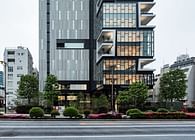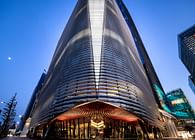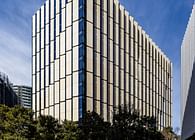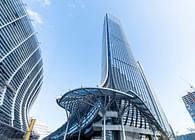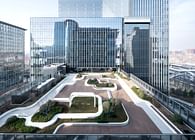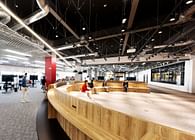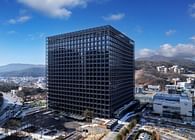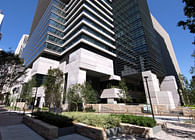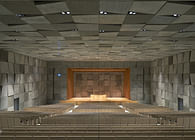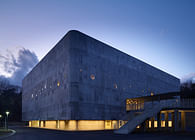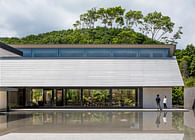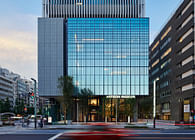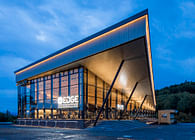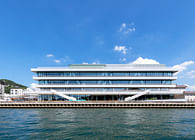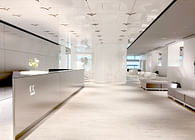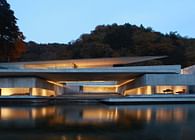
The Hirakata Performing & Visual Arts Center is centrally located in Hirakata City, 30 minutes by train from Osaka and Kyoto, and a five-minute walk from Hirakata Station. Its three halls and art gallery are designed as a space where culture, art and greenery are interwoven, with the aim to create a new city landmark cherished by the citizenry.
Outside, the plaza in front of the facility is dotted with spaces for culture and art, including a grassy area where citizens can easily gather, a shaded area, and a stage. The interior space was created with an awareness of spatial continuity with the exterior, where the courtyard and greened eaves create a space with abundant nature and natural light. We hope that the interior and exterior will support citizens’ artistic activities as a single integrated space.
A compact hall
We sought to create an elegant and refined space befitting a cultural and artistic center, while at the same time pursuing easy-to-use dimensions. The entrance lobby and halls, with their reduced height, allow visitors to enjoy a sense of realism. The height, along with the width of the corridors and the distance between the various rooms, are designed to ensure visibility and intimacy. The facility’s spaces allow people to feel others’ activities as well as the abundant greenery.
The exterior of the building is also purposely less voluminous, as it stands quietly amidst the greenery, affording a sense of security that allows anyone to use the facility and enjoy the front plaza.
Combining functionality and aesthetics in interior and exterior design
The bricks used for the interior and exterior were glazed and created in four different cross-sectional shapes to achieve the kind of sound diffusion and reflection qualities that are important for the hall's acoustic environment. We hope that the massive hall and the wood and brick-based entrance will furnish a high-quality atmosphere, and that the facility will come to be a place where citizens can fully enjoy the arts.
Radiant air conditioning & environmental consciousness: a theater first
In a large space such as a hall, air conditioning processes use large volumes of air. Measures are therefore required to prevent drafts and uneven temperature distribution due to elevation differences. In this project, radiant air conditioning was adopted for the first time in a hall. Radiator panels were placed on the backs of the seats, on the ceiling surfaces above the 1st floor seats, and in the rear of the 2nd floor seats where the ceiling height is low.
Radiant air conditioning must also supply a minimum amount of outside air to the hall. However, equipment was tuned so that air drafts were rendered indiscernible. Thermal comfort was confirmed by simulations during the design stage and by lab tests and mock-ups during construction. In a post-construction questionnaire conducted during an actual performance, more than 95% of the audience responded that the interior conditions felt “normal” or better among five choices: "comfortable", "somewhat comfortable", "normal", "somewhat uncomfortable", and "uncomfortable”.
Hot and cold water used for the radiant air conditioning is produced by a water source heat pump that uses highly treated sewage water, an unutilized energy resource.
Solar panels have been installed on the rooftop to charge electric vehicles and to provide power for common area lighting, etc. In case of emergencies, a reverse power transmission system allows electric vehicle batteries to illuminate lights in the facility’s common areas, etc. for BCP (business continuity plan) service.
In addition, various energy-saving technologies have been adopted, such as a heat source system using thermal water storage and a high-efficiency screw chiller (vapor compressor), an outside air cooling system, and CO2 suppression. These have helped the facility to earn a ranking of “S” (Excellent), according to the Comprehensive Assessment System for Built Environment Efficiency (CASBEE) environmental performance rating system.
Solid brick finish affords rich acoustic resonance
In order to ensure sufficient early reflected sound, the basic shapes of the large and small halls were designed for smooth continuity and unification between the stage and audience seats. The halls’ floor plan and cross section were decided with consideration for the proportion of ceiling heights and audience seat widths. The main reflective surfaces, the acoustic reflectors and the side walls of the seating area are finished with brick, rigid enough for low-frequency reflection, and have appropriate surface roughness. To enhance sound diffusion, several types of bricks were used in an array of stacking methods. In the main hall, a continuous eave-like reflective surface stretches from the stage to the audience seats to further increase reflective sounds. Rectangular and flat, the event hall also features uneven wall brickwork to prevent flutter echoes.
By using a vibration/sound insulation structure and expansion joints around the small hall perimeter, high sound insulation performance was achieved between the large and small hall venues, where both loud noise and silence are expected. The walls of the small hall are brick-finished, which affords sound and vibration insulation. In the event hall, where the large first floor opening allows for integration with the entrance lobby, a double layer of moving partition walls and entry/exit doors provides ample soundproofing. On the second floor, sound insulation is accomplished with 15mm + 15mm laminated glass. The rehearsal room, located diagonal to and below the main hall, employs a sound and vibration isolation structure.
The main hall radiator panels were installed after careful testing and examination at each stage of design and construction to ensure against vibration clatter, even in the presence of loud music.
Project Details
Project name: Hirakata Performing & Visual Arts Center
Purpose: Theater
Location (prefecture, city): Osaka Prefecture, Hirakata City
Site area (sq.m.): 13,146.62
Total floor area (sq.m.): 14,383.75
Number of floors: One below ground, five above-ground, one penthouse level
Eave height/maximum height (m): Eave height = 28.2 m/ Maximum height = 29 m
Main structure: Reinforced concrete, partially steel-framed reinforced concrete, steel
Completion: May 2021
Client name: Hirakata City
Lead architect: Nikken Sekkei Ltd
Main scope: Schematic design, design development, site supervision
Construction company: MAEDA CORPORATION
Photography credit: Akira Ito, aifoto
Status: Built
Location: Hirakata, JP
Firm Role: Schematic design, design development, site supervision
Additional Credits: Construction company: MAEDA CORPORATION
